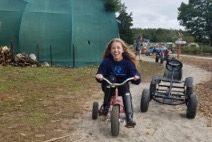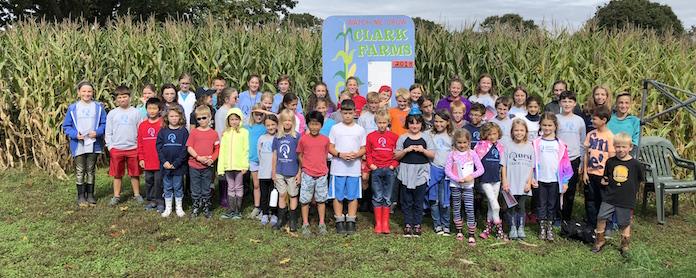Good Morning Middle School Community,
As you may have noticed, this newsletter was published late, but that does not mean that we have been up to nothing. In fact, this letter was published late because we are doing so much!
On the Friday of spirit week, we went on a field trip to Clark Farms, where the middle schoolers led the Upper Elementary and Lower Elementary students on four fun activities. The first one was the corn maze. All of the students had an enjoyable time while navigating with peers through the maze. The second activity was the hayride, where we saw flowers as tall as us and bees made from hay bales! Afterward, we went on the giant slide. It is probably one of the longest slides in Rhode Island, and we had a blast zooming and laughing down the slide! Finally, we had a well-deserved break where students could spend time enjoying the petting zoo, or racing around a track in pedal power go karts or tricycles.


The Wood-Pawcatuck Watershed Association
Wow, what a day we had last Thursday on the science field trip to the Wood-Pawcatuck Watershed Association. The middle school students very much enjoyed the kayaking experience. It was educational too, because we looked for signs of human impact and things that have happened naturally, which we recorded in our field journals. Afterwards we had lunch while we engaged in a conversation about everyone’s crazy uncles and the nicknames they call us. Then we headed downstream to catch macroinvertebrates. We found mayflies, stoneflies, crayfish, whirligig beetles, amphipods and isopods. These macroinvertebrates indicate good water quality. When we were done by the river, we brought our findings back to the lodge, and identified them as well as learned about their impact in the Wood Pawcatuck Watershed. We also did a dissolved oxygen test and the water was FULL of dissolved oxygen, which is a good thing. The more the merrier! To top it off there was the musical bus ride home full of singing to our favorite tunes.
Math to the Moon
Boy, do we have a crazy thing to tell you. In math this week, we calculated how many pieces of paper it would take to stack to the moon. THE MOON! The moon is thousands of miles away and paper is as thin as, well, paper! Blue had taught us the concept, and then we solved the problem to find out that it would take 427,111,111,111.(1’s forever) pieces of paper to make it to the moon. So, if you were planning on climbing paper to the moon, sorry to burst your bubble, but you are either going to need a lot of money or own a paper-making company (or maybe work at NASA:).
Soil Sciences
Last Tuesday we got an exciting visit from Lacey’s friend Ed Avizinis. He is a soil scientist and the person who surveyed Quest’s current site for stormwater runoff. When he visited, the first thing he did was pass around a deer skull and and antlers along with a coyote pelt! We then received a blank map of the school and were asked to go around the school grounds to locate the different materials and features, for example storm drains, rocks, or dirt. Because Ed is a soil scientist, he taught us how to tell if there is wetland where you are standing by looking at the color of the dirt. For example if the dirt is brown and crumbly for 1 inch or so then a sort of rusty color, you are on dryland. Now, if it was all kind of brown and a bit less crumbly you would be on wetland. The wetland is brown and the dryland is rusty because the dryer soil has more iron in it, and the wetland does not because the water flushes most of it out. We really enjoyed having Ed visit and learned a lot from him.
Class Snacks
Our Culinary Manager has been working hard to cook up fun, easy ideas for our classroom snacks and this one has probably been the best so far. Last week Delia made a delicious lemon curd. It was hands down amazing! It was so good a few people even put it in a mason jar and brought it home. It was served with strawberries, but to be honest, we ended up using spoons because it was just too darn good for a strawberry. The lemon curd was made with: eggs, sugar, butter, lemon juice and lemon peel. This week were keeping our eyes peeled for another delicious snack.
Microbusiness
As some of you may have heard, the middle school students have started a microbusiness that consists of bread, candles and jam. Unfortunately, we can’t seem to find the previous middle school bread recipe so we have been trying new ones. Last week we made one that tasted delicious and was mainly white bread flour but also consisted of some whole wheat flour. But, it was not the same because the crust became soft after it cooled. This week we are going to try the same ingredients but we are going to cook it a little differently. Hopefully this week’s batch will not fall flat from our expectations!
Visiting URI
This Tuesday the middle school students hopped on the bus to go on yet another field trip. This time we went to URI, but not for our peace and leadership studies. This time we went for…(drumroll please) science! This week we got to learn about the effect water has when it rains and how watersheds affect that. At URI they had a augmented reality sandbox. It was very cool. It had a projector on top of it that reads the elevation and projected a topography map across the top of it. If you were to knock down a hill the elevation and projection would change with it. The same thing would happen if you were to build a hill. We also got to build a “village” out of recycled plastic sand. Once we were done building the “village” we turned on a little hose at the end of the table which caused water to run through it. The first time a lot of our houses were not protected from the water flow and got swept away. On the second time we had walls, dams, and some funnels to direct water away from our houses. The second time was much more successful and the houses, for the most part, were okay. In the end, we learned the importance of waterflow and where the water sheds (watershed; see what I did there?) are placed, because if you build a house where rainwater tends to flow, chances are your house will not be there too long.
From your middle school correspondent who advises not to eat a lot of lemon curd,
M. O’Neill
